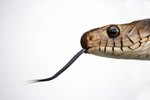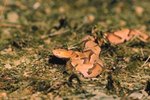
Thousands of wildlife species flourish in Pakistan’s diverse landscape of highlands, plateau and plains, making their home in the tropical to temperate climate that wildly fluctuates between flood and drought. Among the rich tapestry of flora and fauna are 67 species of snakes. From the mostly harmless colubrids to the deadly Russell's viper, there are a host of sea snakes, vipers, pit vipers, blind snakes, kraits, cobras, thread snakes, boas and pythons.
Colubridae and the Common Kukri
With 1,938 species throughout the world, Colubridae are the largest family of snakes alive today. They are not a natural order, but a conglomerate or catchall bin of several unrelated, mostly harmless species; many still waiting to be categorized.
Some 32 species of colubrids live in Pakistan, among them the common kukri. Reaching a length of only 2.5 feet, this shy, black-banded brown snake prefers dark surroundings, such as caves, termite mounds, under leaf debris or rocks, and in dumps. Feeding mainly on small prey -- skinks, geckos, insects, larvae and reptile eggs -- the nocturnal kukri is totally harmless and rarely encountered by humans.
Russell's Viper
The most common viper in Pakistan is the Russell’s viper, also known as the “chain viper” from the genus Daboia. Although it's primarily nocturnal, during the day the Russell’s viper may be found basking under shrubs, which accounts for most reported cases of bites on humans when they mistakenly step on the snake in its natural habitat. The bite causes pain, swelling and bleeding, leading to decreased blood pressure and reduced heart rate. The mortality rate of victims is 40 to 92 percent.
A handsome snake, the yellowish-brown adults are 3 to 5 feet long and feed on rodents, birds lizards, squirrels, crabs and scorpions.
Himalayan Pit Viper
With an average length of about 3 feet, the Himalayan pit viper is the only pit viper in Pakistan. Pit vipers have a pit, or fossa, on either side of their head in the loreal region between the eye and nostril; these external openings lead to highly sensitive and complex infrared-detecting, or heat-sensing, organs. They are, in effect, a sixth sense that enables the pit viper to not only find prey, but also to judge the relative size of its warm-blooded victims.
Common Indian Krait
The common Indian krait is non-aggressive, however, if taken by surprise it will bite, injecting lethal venom that causes sleepiness and, ultimately, respiratory failure. This deadly snake grows an average of 4 feet long. Its diet consists of lizards and snakes. Like many snake species, the krait is cannibalistic, preying upon and eating its own kind.
Indian or Red Sand Boa
Pakistan is home to the Indian or red sand boa, the largest member of the boa (Boidae) family found in India. Boas are relatively primitive snakes, retaining several characteristics of their limbed ancestors, such as a pelvic girdle and small back claws or spurs where back limbs once grew.
Non-venomous and secretive, the red sand boa grows up to 4 feet long, although rarely more than 3 feet. It's nocturnal and spends most of its time underground. Its diet consists of rodents, lizards and other snakes, which it seizes with its mouth, then suffocates by muscular constriction. When the prey is dead, the boa swallows it head first.
Unlike the old world egg-laying pythons, new world boas bear live young.
References
Photo Credits
-
Comstock/Comstock/Getty Images
Writer Bio
Based in Ontario, Susan Dorling has written professionally since 2000, with hundreds of articles published in a variety of popular online venues. Writing on a diverse range of topics, she reflects her passion for business, interior design, home decorating, style, fashion and pets.




